2014 HONDA PILOT tow
[x] Cancel search: towPage 324 of 488

323
Driving
This chapter discusses driving, refueling, and information on items such as accessories.
Before Driving
Driving Preparation .......................... 324
Maximum Load Limit........................ 327
Towing a Trailer Towing Preparation .......................... 329
Driving Safely with a Trailer .............. 338
Towing Your Vehicle ........................ 339
Off-Highway Driving Guidelines General Information ......................... 340
Important Safety Precautions............ 340
Avoiding Trouble ............................. 341
When Driving Starting the Engine .......................... 342
Precautions While Driving................. 344 Automatic Transmission ................... 345
Shifting ............................................ 346
Cruise Control ................................. 348
VSA® (Vehicle Stability Assist), aka ESC
(Electronic Stability Control), System ...... 352
VTM (Variable Torque Management)-4 r
System *.............................................354TPMS (Tire Pressure Monitoring System) ... 355Tire Pressure Monitoring System (TPMS) -
Required Federal Explanation ......... 357
Braking Brake System ................................... 360
ABS (Anti-lock Brake System) ........... 362 Brake Assist System ......................... 363
Parking Your Vehicle When Stopped ................................ 364
Parking Sensor System
*...................365
Rearview Camera *............................369
Multi-View Rear Camera *................370
Refueling
Fuel Information .............................. 371
How to Refuel ................................. 372
Fuel Economy ..
.................................. 374
Accessories and Modifications Accessories ...................................... 375
Modifications................................... 375
* Not available on all models
Page 326 of 488

Continued325
uu Before Driving u Driving Preparation
Driving
• Store or secure all items on board properly.
u Carrying too much cargo, or improperly storing it, can affect your vehicle's
handling, stability, sto pping distance, and tires, and make it unsafe.
2Maximum Load Limit P. 327
• Do not pile items higher than the seat height.
u Th
ey can block your view and may be thrown forward in the event of sudden
braking.
• Do not pla
ce anything in the front seat footwells. Make sure to secure the floor
mat.
u An object or unsecured floor m
at can interfere with your brake and accelerator
pedal operation while driving.
• If yo
u have any animals on board, do not let them move around in the vehicle.
u Th
ey may interfere with driving and a crash could occur.
• Secure
ly close and lock al l doors and the tailgate.
2Locking/Unlocking the Doors from the Inside P. 103
• Adjust your seating position properly.
u Adjust the head re
straint, too.
2Adjusting the Seats P. 137
2 Adjusting the Head Restraints P. 141
•Adjust the mirrors and steering wh eel properly for your driving.
u Ad
just them while sitting in the proper driving position.
2 Adjusting the Steering Wheel P. 134
2 Adjusting the Mirrors P. 135
■Interior Checks1Interior Checks
The headlight aim is set by the factory, and does not
need to be adjusted. Howeve r, if you regularly carry
heavy items in the cargo area or tow a trailer, have
the aiming readjusted at a dealer or by a qualified
technician.
Page 328 of 488
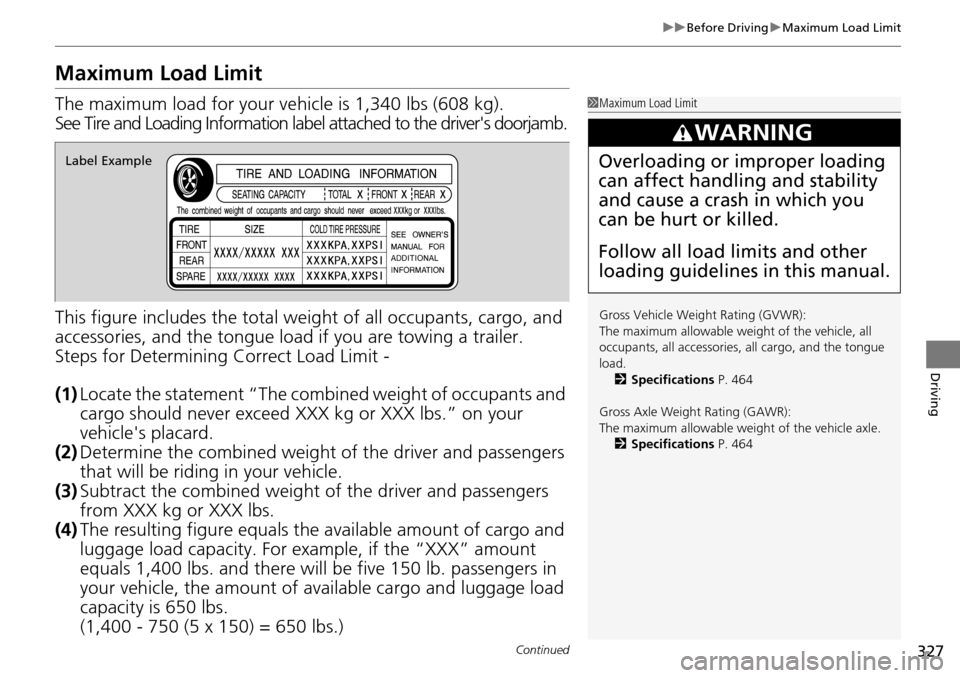
327
uu Before Driving u Maximum Load Limit
Continued
Driving
Maximum Load Limit
The maximum load for your ve hicle is 1,340 lbs (608 kg).
See Tire and Loading Information label attached to the driver's doorjamb.
This figure includes the total weig ht o
f all occupants, cargo, and
accessories, and the tongue load if you are towing a trailer.
Steps for Determining Correct Load Limit
-
(1) Locate
the statement “The comb ined weight of occupants and
cargo should never exceed XXX kg or XXX lbs.” on your
vehicle's placard.
(2) Deter
mine the combined weight of the driver and passengers
that will be riding in your vehicle.
(3) S
ubtract the combined weight of the driver and passengers
from XXX kg or XXX lbs.
(4) T
he resulting figure equals the available amount of cargo and
luggage load capacity. For example, if the “XXX” amount
equals 1,400 lbs. and there will be five 150 lb. passengers in
your vehicle, the am ount of available cargo and luggage load
capacity is 650 lbs.
(1,400 - 750 (5 x 150) = 650 lbs.)
1 Maximum Load Limit
Gross Vehicle Weight Rating (GVWR):
The maximum allowable weight of the vehicle, all
occupants, all a ccessories, all cargo, and the tongue
load. 2 Specifications P. 464
Gross Axle Weight Rating (GAWR):
The maximum allowable weight of the vehicle axle. 2 Specifications P. 464
3 WARNING
Overloading or improper loading
can affect handling and stability
and cause a crash in which you
can be hurt or killed.
Follow all load limits and other
loading guidelines in this manual.Label Example
Page 329 of 488
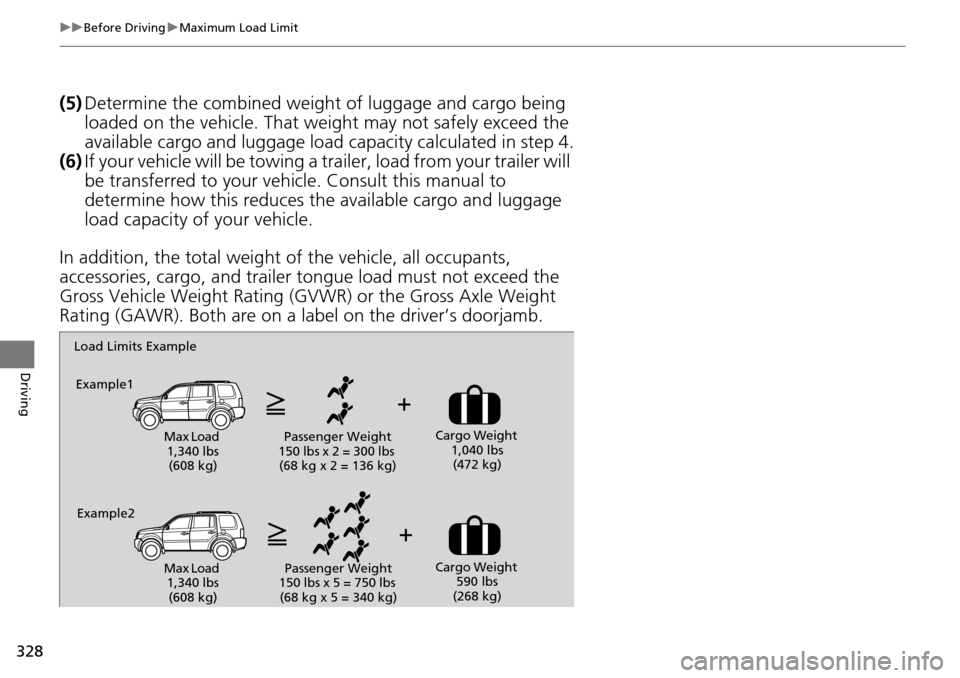
328
uu Before Driving u Maximum Load Limit
Driving
(5) Determine the combined weight of luggage and cargo being
loaded on the vehicle. That we ight may not safely exceed the
available cargo and luggage load capacity calculated in step 4.
(6) If your vehicle will be towing a tra iler, load from your trailer will
be transferred to your vehicl e. Consult this manual to
determine how this reduces the available cargo and luggage
load capacity of your vehicle.
In addition, the total weight of
the vehicle, all occupants,
accessories, cargo, and trailer tongue load must not exceed the
Gross Vehicle Weight Rating (GVW R) or the Gross Axle Weight
Rating (GAWR). Both are on a label on the driver’s doorjamb.
Load Limits Example
Example1
Max Load 1,340 lbs (608 kg) Passenger Weight
150 lbs x 2 = 300 lbs (68 kg x 2 = 136 kg) Cargo Weight
1,040 lbs (472 kg)
Example2
Max Load 1,340 lbs (608 kg) Passenger Weight
150 lbs x 5 = 750 lbs (68 kg x 5 = 340 kg) Cargo Weight
590 lbs
(268 kg)
Page 330 of 488

329Continued
Driving
Towing a Trailer
Towing Preparation
Your vehicle can tow a trailer if you carefully observe the load limits, use the proper
equipment, and follow the towing guidelin es. Check the load limits before driving.
■Total trailer weight
Do not exceed the maximum allowable
weight
of the trailer, cargo, and everything in
or on it shown in the table.
Towing loads in excess of this can seriously
affec
t vehicle handling and performance and
can damage the engine and drivetrain.
Each weight limit is calculated based on the following conditions:
• Occu
pants fill seats from the front of the vehicle to the back
•Each
occupant weights 150 lbs (68 kg)
•Each
occupant has 15 lbs (7 kg) of cargo in the cargo area
Any additional weight, cargo or accessories reduce the maximum trailer weight and
max
imum tongue load.
■Towing Load Limits1Towing Load Limits
Check if all loads are within limits at a public scale.
If a public scale is not av ailable, add the estimated
weight of your cargo load to the weight of your
trailer (as quoted by the manufacturer), and then
measure the tongue load with an appropriate scale or
tongue gauge or estima te it based on cargo
distribution.
Refer to the trailer owner's manual for additional
information.
Break-in Period
Avoid towing a trailer duri ng your vehicle's first 600
miles (1,000 km).
Never exceed the gross weight ratings.
Gross weight information 2 Vehicle Specifications P. 464
3 WARNING
Exceeding any load limit or improperly
loading your vehicle and trailer can cause a
crash in which you can be seriously hurt or
killed.
Check the loading of your vehicle and
trailer carefully before starting to drive.
Total Load
Number of
occupants4WD models2WD models with ATF cooler2WD models
without ATF cooler
24,500 lbs (2,041 kg)3,500 lbs (1,588 kg)2,000 lbs (905 kg)
34,300 lbs (1,950 kg)3,300 lbs (1,497 kg)
Towing not
recommended
44,100 lbs (1,860 kg)3,100 lbs (1,406 kg)
54,000 lbs (1,814 kg)3,000 lbs (1,361 kg)
63,800 lbs (1,724 kg)2,800 lbs (1,270 kg)
72,000 lbs (905 kg)2,000 lbs (905 kg)
8Towing not
recommendedTowing not
recommended
Page 331 of 488
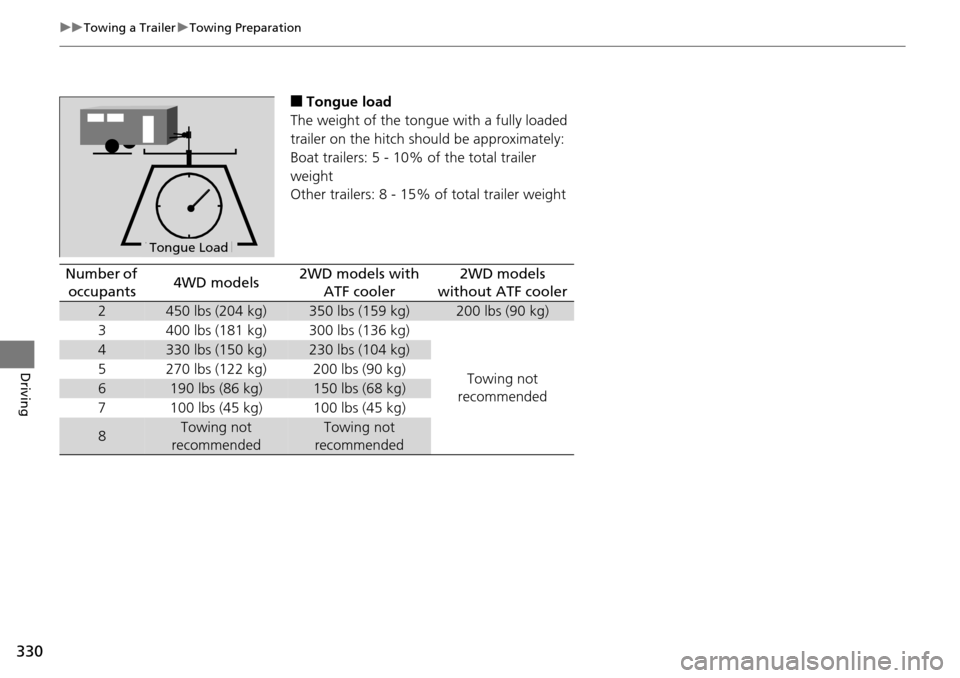
330
uu Towing a Trailer u Towing Preparation
Driving
■Tongue load
The weight of the tongue with a fully loaded
trailer o
n the hitch should be approximately:
Boat trailers: 5 - 10% of the total trailer
wei
ght
Other trailers: 8 - 15% of tot
al trailer weight
Tongue LoadTongue Load
Number of
occupants4WD models2WD models with ATF cooler2WD models
without ATF cooler
2450 lbs (204 kg)350 lbs (159 kg)200 lbs (90 kg)
3400 lbs (181 kg)300 lbs (136 kg)
Towing not
recommended
4330 lbs (150 kg)230 lbs (104 kg)
5270 lbs (122 kg)200 lbs (90 kg)
6190 lbs (86 kg)150 lbs (68 kg)
7100 lbs (45 kg)100 lbs (45 kg)
8Towing not
recommendedTowing not
recommended
Page 332 of 488
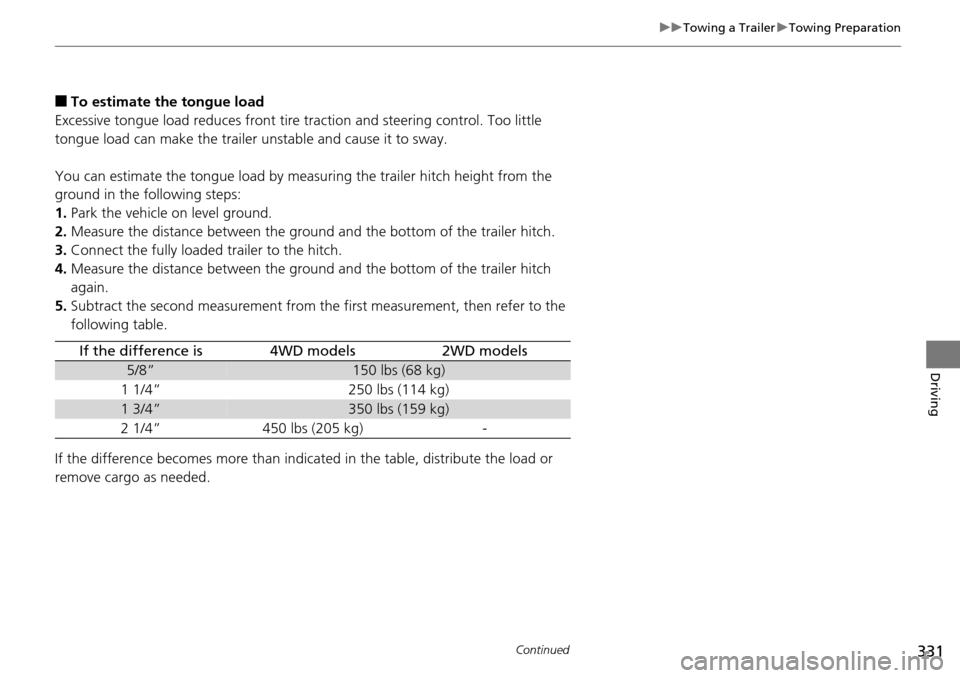
331
uu Towing a Trailer u Towing Preparation
Continued
Driving
■To estimate the tongue load
Excessive tongue load reduces front tire traction and steering control. Too little
tongu
e load can make the trailer unstable and cause it to sway.
You can estimate the tongue load by measuring the trailer hitch height from the
groun
d in the following steps:
1. Park the
vehicle on level ground.
2.Measur
e the distance between the groun d and the bottom of the trailer hitch.
3. Connect
the fully loaded trailer to the hitch.
4.Measur
e the distance between the groun d and the bottom of the trailer hitch
again.
5. Sub
tract the second measurement from the first measurement, then refer to the
following table.
If the difference becomes more than indica ted in the ta
ble, distribute the load or
remove cargo as needed.
If the difference is4WD models2WD models
5/8”150 lbs (68 kg)
1 1/4”250 lbs (114 kg)
1 3/4”350 lbs (159 kg)
2 1/4”450 lbs (205 kg)-
Page 333 of 488
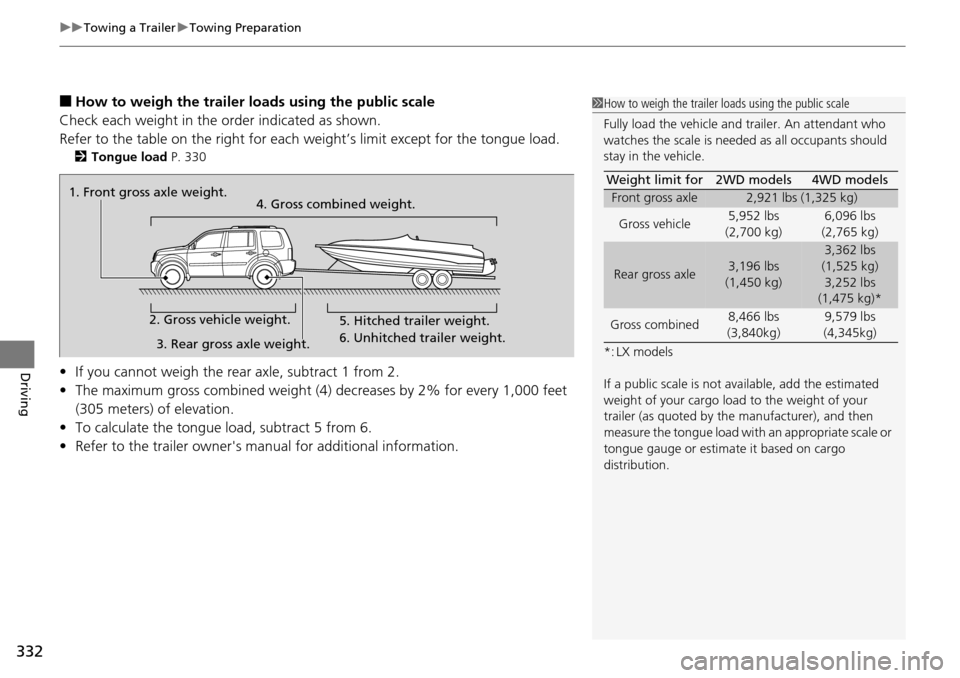
uu Towing a Trailer u Towing Preparation
332
Driving
■How to weigh the trailer loads using the public scale
Check each weight in the order indicated as shown.
Refer to the table on the right for each we i
ght’s limit except for the tongue load.
2Tongue load P. 330
• If you cannot weigh the rear axle, subtract 1 from 2.
• The maximu
m gross combined weight (4) decreases by 2% for every 1,000 feet
(305 meters) of elevation.
• To calculate
the tongue load, subtract 5 from 6.
• Re
fer to the trailer owner's manu al for additional information.
1How to weigh the trailer loads using the public scale
Fully load the vehicle and trailer. An attendant who
watches the scale is needed as all occupants should
stay in the vehicle.
*: LX models
If a public scale is not av ailable, add the estimated
weight of your cargo load to the weight of your
trailer (as quoted by the manufacturer), and then
measure the tongue load with an appropriate scale or
tongue gauge or estima te it based on cargo
distribution. Weight limit for 2WD models 4WD models
Front gross axle2,921 lbs (1,325 kg)
Gross vehicle 5,952 lbs
(2,700 kg) 6,096 lbs
(2,765 kg)
Rear gross axle3,196 lbs
(1,450 kg)
3,362 lbs
(1,525 kg) 3,252 lbs
(1,475 kg)*
Gross combined 8,466 lbs
(3,840kg) 9,579 lbs
(4,345kg)
1. Front gross axle weight.
2. Gross vehicle weight. 4. Gross combined weight.
3. Rear gross axle weight. 5. Hitched trailer weight.
6. Unhitched trailer weight.